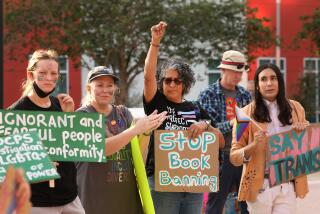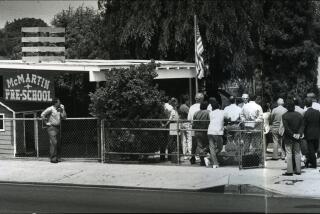In the End, Jury Gave In to Confusion
- Share via
For 15 days the jurors sat in a cramped room on the 11th floor of the courthouse, wading through reams of conflicting testimony. They weighed the children’s fanciful flights of imagination against their testimony of unspeakable acts, and wrestled endlessly with unfamiliar legal and medical definitions, not to mention each other.
In the end, the jurors in the McMartin Pre-School case came away with more questions than answers--”hopelessly and irreversibly hung on all counts” as to the guilt of Ray Buckey, accused of eight counts of molestation involving three children.
Later, as they tried to dissect their feelings, they reached one of the few unanimous moments in their jury duty--expressing frustration that they could not close the book on a case that has haunted so many for so long, and the helplessness they say they felt because there was not enough solid testimony and evidence to reach a decision.
Jury foreman Richard Dunham, 38, wearily summed it up: “We tried very hard. I feel disappointed . . . like we failed.”
In a press conference attended by all 12 and in subsequent interviews, the jurors described their confused and groping efforts to make sense of a judicial riddle that had baffled one previous jury.
Said Dunham: “There was no blue (language) or pounding tables or throwing things, just raised voices. There were even a few light moments--not anything to do with the case--but to break the tension.”
But Dunham said nothing seemed to bring their divergent views together. “We had jurors who remained on both sides of the fence from start to finish. Some jumped around as late as early (Friday) morning,” he added.
“We were all over the map.”
Most jurors concluded that children had been molested. But they were divided over who had done it. They said the prosecution’s case was crippled by controversial interviews with the children, an echo of the original trial that also had focused on the Children’s Institute International controversy.
In the early days of the trial, the jurors said they felt that Buckey must have done something. But as a parade of therapists, parents, children and the defendant himself took the stand, their perceptions dissolved into uncertainty.
They seemed most troubled by the way therapists interviewed the children about the alleged molestations--evidence that was central to the entire case. Some jurors said they believed the children were coaxed into reaching the conclusions that they did.
“They kept asking children questions and leading them until they got what they wanted to hear,” said juror Lloyd Issacson, 64, a Treasury Department official.
Superior Court jurors in Buckey’s first molestation trial agreed that the techniques of the therapists left much to be desired. But they reached a slightly different conclusion on Buckey’s role. Most said they felt Buckey had molested the children, but that the prosecution’s case was not proven beyond a reasonable doubt.
Nonetheless, jurors in the first trial acquitted Buckey on 40 counts but were unable to reach a conclusion on the remaining 13. Ultimately, Dist. Atty. Ira Reiner decided to retry Buckey on eight counts.
In this retrial, the jury managed to reach a verdict on two charges, both acquittals. However, after a rereading of testimony by a key prosecution medical witness, they began butting heads again, changing positions until there was no consensus.
The final tally showed the jury leaning toward conviction on one count by a vote of 8 to 4 and split evenly on a second count. On the remaining six counts, the jury clearly leaned toward acquittal, casting votes that ranged from 7 to 5 on one count, to 11 to 1 on three others.
After 11 days of deliberations and two ballots, the jurors told Superior Court Judge Stanley Weisberg that they were deadlocked. He sent them back in hopes that another look at the evidence would break the impasse.
Instead, after spending several days more listening to testimony being reread to them by a court clerk, they found themselves further apart than ever.
“We went back to deliberate and went the opposite direction. We got more hung than less hung,” said Dunham.
One juror, Mary Scott, 51, a medical technician, described it as “excruciating,” especially the attempts to untangle the meaning of legal terms. “For one thing, we didn’t know the law and had to do the best we could, which isn’t good enough.”
Some of the jurors said they accepted the defense notion that children do lie. One juror, discussing the testimony of one child about bubble baths taken in a costume shop, noted that the child was unable to make eye contact with Buckey’s lawyer.
Said juror Michael Carapella, a 25-year-old musician: “Because we did not have (information) we needed, I could explain away everything.”
Jurors were especially appalled that the interviews conducted by therapists from Children’s Institute International were done so badly. Some expressed concern that the therapists cut the children off when they were making spontaneous revelations.
“The (institute’s) tapes were terrible,” said juror Silvia Scrigna, 30, a bank employee.
Another obstacle arose, jurors said, during “endless and agonizing” discussions over the medical definition of “vaginal area.”
Issacson said he was especially troubled by the contrast between the testimony of the prosecution’s medical expert, Astrid Heger, and the girls’ own pediatricians. Heger said all the children showed signs of anal and vaginal scarring consistent with molestation. The girls’ own physicians said they found no such evidence.
Some of the children testified that Buckey had used his finger to penetrate them. The jurors, in turn, said that during deliberations they even measured each other’s fingers to try to determine if what was described in testimony was physically possible.
During the last hours of deliberations, there was “an atmosphere of futility,” Carapella said.
Juror Scott added: “We had to do the best we could, and that’s really, frankly, not good enough--to be deciding the outcome of either side’s life.”
Said Issacson in conclusion: “I don’t think you could ever get 12 people together who could make a unanimous decision on this.”
More to Read
Sign up for Essential California
The most important California stories and recommendations in your inbox every morning.
You may occasionally receive promotional content from the Los Angeles Times.










